lives lost
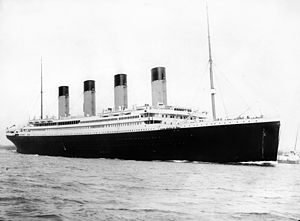 On this, the 105 anniversary of the April 10, 1912 sailing of the RMS Titanic, for her maiden and only voyage, my thoughts have been leaning toward the people who were on board, and particularly those who did not survive that fateful trip. The Titanic was the most amazing ship of it’s time, filled with luxuries beyond the imagination…at least in first class. Back then, people were separated into classes based on their social importance. It’s sad to think about that, because every person has value, and many of those in 3rd class, or steerage were considered expendable. Nevertheless, it was not just those in steerage who lost their lives when Titanic went down on April 12th, 1912.
On this, the 105 anniversary of the April 10, 1912 sailing of the RMS Titanic, for her maiden and only voyage, my thoughts have been leaning toward the people who were on board, and particularly those who did not survive that fateful trip. The Titanic was the most amazing ship of it’s time, filled with luxuries beyond the imagination…at least in first class. Back then, people were separated into classes based on their social importance. It’s sad to think about that, because every person has value, and many of those in 3rd class, or steerage were considered expendable. Nevertheless, it was not just those in steerage who lost their lives when Titanic went down on April 12th, 1912.
As Titanic set sail on April 10th, here was much excitement. Those who were “lucky” enough to have secured passage, were to be envied. Of course, the rich and famous had no trouble paying for their passage, but the less fortunate had a different situation, and different accommodations. Many of the steerage passengers had spent their last penny to pay for their passage, and still they considered it money well spent, because they were heading to America for a better life. Little did any of the passengers in all three classes know that in just two days, their beautiful ship would be at the bottom of the ocean, along with many of her passengers and crew. It is here that I began to wonder what they were thinking as the ship sank beneath their feet, into the deep dark  murky depths. I know most of them were just trying to find a way to get onto one of the life boats…of which there were too few by at least half, but did it also become that moment when they thought about what might have been for them…had they not taken this particular trip, on this particular ship. I think that anytime a person finds themselves faced with death, their thoughts turn to family, friends, and what might have been. Most luxury trips taken are for a few reasons…among them the scenery, a long awaited visit, or just the sheer luxury of this particular type of trip. No one really considers what might happen if things go wrong, or at the very least, we try not to think about it. Still, when the moment of emergency arrives, did the passengers of Titanic think that if only they had waited for Titanic’s next trip, they wouldn’t be here today…in this most horrible of situations, with so many others screaming in fear, because they knew they were about to die…unless a miracle happened for them.
murky depths. I know most of them were just trying to find a way to get onto one of the life boats…of which there were too few by at least half, but did it also become that moment when they thought about what might have been for them…had they not taken this particular trip, on this particular ship. I think that anytime a person finds themselves faced with death, their thoughts turn to family, friends, and what might have been. Most luxury trips taken are for a few reasons…among them the scenery, a long awaited visit, or just the sheer luxury of this particular type of trip. No one really considers what might happen if things go wrong, or at the very least, we try not to think about it. Still, when the moment of emergency arrives, did the passengers of Titanic think that if only they had waited for Titanic’s next trip, they wouldn’t be here today…in this most horrible of situations, with so many others screaming in fear, because they knew they were about to die…unless a miracle happened for them.
Titanic was carrying 2,222 people (passengers and crew), when she set sail. Of those people only 706 would receive that miracle. For the rest, this would be the end of their life. Of the 706 survivors, 492 were passengers, and 214 were crew members, a fact that I find rather odd. The class distinctions were closer to expected, with 61% of first class passengers surviving, 42% of second class passengers surviving, and 24% of third class passengers surviving. That is a sad reality of a time when class was everything. I’m sure that all of 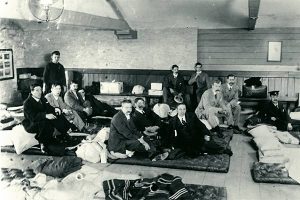 these people felt that their lives were a tremendous gift, and I’m sure too that their lives changed in a big way. Still, I wonder about the final thoughts of the 1516 people who died that day. I’m sure they wished they had not taken the trip, and I’m sure that they regretted the fact that their family would be sad. It really doesn’t matter what they were thinking, I guess, because it was too late to change what was…for most of them anyway. For the holder of Ticket number 242154, it appears that it was not to late. The holder of that ticket is unknown, but they were given a full refund for their ticket, and it appears that they did not sail on Titanic. Perhaps, they had their ear to the Lord’s Word, and were told not to sail. Not knowing who this person was, we will never know for sure.
these people felt that their lives were a tremendous gift, and I’m sure too that their lives changed in a big way. Still, I wonder about the final thoughts of the 1516 people who died that day. I’m sure they wished they had not taken the trip, and I’m sure that they regretted the fact that their family would be sad. It really doesn’t matter what they were thinking, I guess, because it was too late to change what was…for most of them anyway. For the holder of Ticket number 242154, it appears that it was not to late. The holder of that ticket is unknown, but they were given a full refund for their ticket, and it appears that they did not sail on Titanic. Perhaps, they had their ear to the Lord’s Word, and were told not to sail. Not knowing who this person was, we will never know for sure.
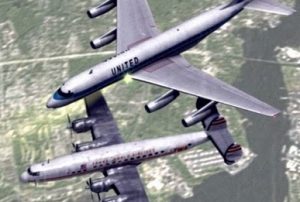
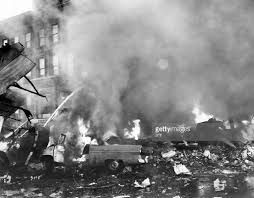 With the thousands of airplanes in the air at any moment, one might think that daily accidents would be common place, but in reality, air travel is actually very safe. Nevertheless, it is not without its tragedies. What tends to amaze me, however, is the fact that relatively few ever seem to crash in a city, even though the airports are usually very near cities. Still, there is not a perfect record of missing the cities, when it comes to plane crashes either, and when a plane crashes in a city, you know that the death toll will be higher, and more than likely will include people on the ground, who were just going about their day, completely unaware of the danger they were in.
With the thousands of airplanes in the air at any moment, one might think that daily accidents would be common place, but in reality, air travel is actually very safe. Nevertheless, it is not without its tragedies. What tends to amaze me, however, is the fact that relatively few ever seem to crash in a city, even though the airports are usually very near cities. Still, there is not a perfect record of missing the cities, when it comes to plane crashes either, and when a plane crashes in a city, you know that the death toll will be higher, and more than likely will include people on the ground, who were just going about their day, completely unaware of the danger they were in.
Such was the case on this day, December 16, 1960, in New York City, when two commercial airliners, a United 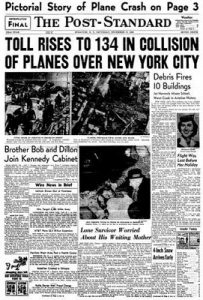 DC-8 from Chicago, that was heading to Idlewild Airport…now renamed John F Kennedy International Airport, in southern Queens, and a TWA Super Constellation from Dayton, Ohio that was heading to LaGuardia Airport in northern Queens, collided over the city, killing 134 people in the planes and on the ground. This remains the only such accident to occur over a major US city to this day. It was snowing that morning, and the United flight had been put into a holding pattern. Unfortunately, the pilot miscalculated the location of the pattern, the plane came directly into the path of the TWA flight, who was on approach to LaGuardia Airport. There were 128 people onboard the two planes, and all of them, except eleven year old Stephen Baltz were killed on impact. The boy would die from his injuries the next day, but he was lucid enough to give a brief account of the accident, saying that, “It looked like a picture out of a fairy book. Then all of a sudden there was an explosion. The plane started to fall and people started to scream. I held on to my seat and then the plane crashed.”
DC-8 from Chicago, that was heading to Idlewild Airport…now renamed John F Kennedy International Airport, in southern Queens, and a TWA Super Constellation from Dayton, Ohio that was heading to LaGuardia Airport in northern Queens, collided over the city, killing 134 people in the planes and on the ground. This remains the only such accident to occur over a major US city to this day. It was snowing that morning, and the United flight had been put into a holding pattern. Unfortunately, the pilot miscalculated the location of the pattern, the plane came directly into the path of the TWA flight, who was on approach to LaGuardia Airport. There were 128 people onboard the two planes, and all of them, except eleven year old Stephen Baltz were killed on impact. The boy would die from his injuries the next day, but he was lucid enough to give a brief account of the accident, saying that, “It looked like a picture out of a fairy book. Then all of a sudden there was an explosion. The plane started to fall and people started to scream. I held on to my seat and then the plane crashed.”
The TWA plane crashed onto Miller Field, a military airfield on Staten Island. The United flight, which was missing its right engine and part of a wing, came down in the middle of the Park Slope neighborhood of Brooklyn, narrowly missing Saint Augustine’s Academy. It hit an apartment building and the Pillar of Fire Church. Dozens of other buildings caught fire in the resulting explosion. Mrs Robert Nevin, who was sitting in a 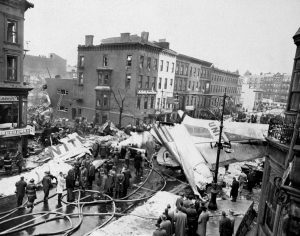
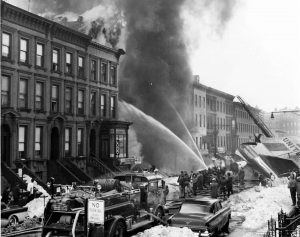 top floor apartment when the place crashed into her building, later said “The roof caved in and I saw the sky.” Six people on the ground died when the plane crashed, including the 90 year old caretaker of the church, Wallace Lewis, and two men who were selling Christmas trees nearby. Christmas presents carried by the plane’s passengers were strewn all over the streets. Firefighting efforts went on for nearly 72 hours because of the multiple fires.
top floor apartment when the place crashed into her building, later said “The roof caved in and I saw the sky.” Six people on the ground died when the plane crashed, including the 90 year old caretaker of the church, Wallace Lewis, and two men who were selling Christmas trees nearby. Christmas presents carried by the plane’s passengers were strewn all over the streets. Firefighting efforts went on for nearly 72 hours because of the multiple fires.
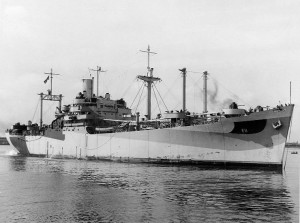 Any time ammunition, explosives, and bombs are being stored in a smaller space, and handled by multiple people, there is a possibility of disaster. The USS Mount Hood was the lead ship of her class of ammunition ships for the United States Navy in World War II. Her life was short lived. The North Carolina Shipbuilding Company began work on the ship on September 28, 1943, and the intended name of the ship was SS Marco Polo. It was first launched on November 28, 1943, and aquired by the Navy on January 28, 1944. It was commissioned the USS Mount Hood on July 1, 1944. The ship was named after Mount Hood, the volcano in the Cascade Range in Oregon.
Any time ammunition, explosives, and bombs are being stored in a smaller space, and handled by multiple people, there is a possibility of disaster. The USS Mount Hood was the lead ship of her class of ammunition ships for the United States Navy in World War II. Her life was short lived. The North Carolina Shipbuilding Company began work on the ship on September 28, 1943, and the intended name of the ship was SS Marco Polo. It was first launched on November 28, 1943, and aquired by the Navy on January 28, 1944. It was commissioned the USS Mount Hood on July 1, 1944. The ship was named after Mount Hood, the volcano in the Cascade Range in Oregon.
Following a short fitting out and shakedown period in the Chesapeake Bay area, the USS Mount Hood reported for duty to ComServFor, Atlantic Fleet on August 5, 1944. She was assigned to carry cargo to the Pacific, and she pulled in to Norfolk, where her holds were loaded. The she was transfered to the Panama Canal as part of 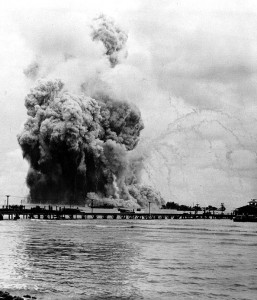 Task Group 29.6. She finally ended up Seeadler Harbor at Manus Island of the Admiralty Islands on September 22, 1944. There she was assigned to ComSoWesPac. The ship was to be dispensing ammunition and explosives to ships preparing for the Philippine offensive.
Task Group 29.6. She finally ended up Seeadler Harbor at Manus Island of the Admiralty Islands on September 22, 1944. There she was assigned to ComSoWesPac. The ship was to be dispensing ammunition and explosives to ships preparing for the Philippine offensive.
At 8:30am, on November 10, 1944, 17 of USS Mount Hood’s crew members, including Lieutenant Lester H Wallace left the ship to go ashore. At 8:55am, while walking on the beach the men saw a flash and heard two quick explosions. They immediately jumped back in their boat and headed for their ship, only to find that, like volcanoes tend to do, the USS Mount Hood had exploded. There was literally no ship to come back to, and other ships in the area were heavily damaged too. The USS Mount Hood had been anchored in 35 feet of water, and had exploded with an estimated 3,800 tons of ordnance material on board. Mushrooming smoke rose to 7,000 feet, completely obscuring the ship and the surrounding area for approximately 500 yards. It was easy to see where USS Mount Hood had been, because the explosion created a trench in the ocean floor 1,000 feet long, 200 feet wide, and 40 feet deep.The largest remaining piece of the hull was found in the trench and measured about 16 feet by 10 feet. No other remains were found except the fragments which struck the other ships in the area. No human remains were recovered of the 350 men aboard USS Mount Hood or the small boats loading alongside at the time of the explosion.

There were 271 men in surrounding ships that were injured, and 82 of nearby Mindanao’s crew were killed. In all, 22 small boats and landing craft were sunk, destroyed, or damaged beyond repair. The exact cause of USS Mount Hood’s explosion was never determined, but since the possibility of enemy action was remote, it was thought that rough handling of some of the explosives during the loading and unloading process was to blame for the disaster. With no survivors and so little of the ship left, I’m sure that the investigation was an impossible task. I do find it ironic that a ship named after a volcano, ended up exploding, and I find the loss of life to be a very sad thing indeed.

